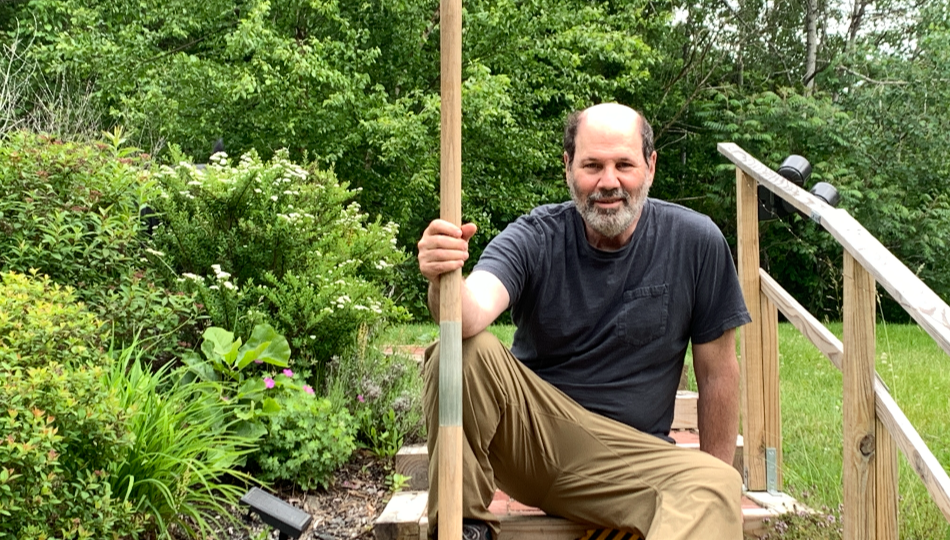Written by Dan Tobin
It’s an unseasonably hot day, and I’m sitting in a pile of dirt in my front yard surrounded by bags of gravel, sand, and stone dust. I’m feeling great—the best I’ve felt since being diagnosed with Parkinson’s two years ago. Lugging around 50-pound bags has left me both exhausted and energized. It’s all part of my summer project to rebuild the outdoor steps and the 60-foot walkway to my front door.
Twenty-four hours later, despair kicks in. My brother Joe and my nephew Sam have traveled from out of town to help me for a few days. We’ve made great progress, but the scope of the job suddenly seems overwhelming. I’m in over my head—literally. The steps and walkway need to climb nearly six feet to the house’s front stoop and turn more than 90 degrees along the 60-foot path. It’s like a nightmare math story problem of my own making:
A semi-retired publisher with Parkinson’s, age 63, and two professors (ages 70 and 40) are building a 60-foot walkway and steps with a 62-inch rise and a 95-degree turn. How long before they give up and call in professionals? Show your work.
Miraculously, 48 hours later, we are done. The steps and walkway look great and there have been no trips to the ER. Somewhere along the 60-foot journey, the DIY walkway project morphed into DIY therapy, boosting my confidence and turning back the clock on the disease—for a bit anyway. The key ingredients of the treatment plan were the physical exhaustion of the work combined with dark humor and fraternal teasing.
Disclaimer: Please consult a neurologist and a stone mason before trying this at home.
Freud, Spielberg, and Piles of Dirt
Looking back, I wonder about the role Parkinson’s played in my decision to tackle this huge project. Yes, strenuous exercise is one of the best things you can do to slow down (but not reverse) the relentless attack of Parkinson’s on your brain and limbs. There’s also the race-against-time element; I wanted to prove to myself that I could still lift heavy objects and operate dangerous machinery, however ill-advised that might be.
But I knew there was more than that going on. I didn’t need a therapist to explain why someone with a degenerative movement disorder marked by shakiness and balance issues might be driven subconsciously to build something as stable and lasting as a brick walkway. The Freudians, including my 95-year-old psychoanalyst father, would call that sublimation—subconsciously channeling anxieties about one thing (Parkinson’s in my case) into something positive, like oil painting or home projects. The flipside of sublimation is displacement: exchanging one set of anxieties for another set. For example, if my urge to build the walkway were to become obsessive or delusional like Richard Dreyfuss digging up his backyard in Close Encounters of the Third Kind. And if Joe and Sam hadn’t come to bail me out, I would have spent months up to my waist in piles of dirt, sand, and brick.
Another Brick in the Stairway to Heaven
But let me get back to safer ground: the power saws and the landscape timber. The steps I had built a decade ago had developed an unsettling trampoline effect, and I started building the new steps a week before my “crew” arrived.
My first stop was YouTube—the DIY-er’s best friend and worst enabler. After fast-forwarding through dozens of videos, I opted for a modular design with wooden frames containing squares of 24 bricks (three rows with eight bricks in each row).
 I set about building the frames only to be confronted with more math: How many frames and lumber pieces would I need for the whole project—steps, and walkway? That depended on a number of variables, starting with the height of each step and the slope of the rise. My research produced advice like this: “Divide the riser height by the tread width and then calculate the inverse tangent.” I chose, instead, to build sample steps of different heights and recruited various family members testers to choose the most comfortable option, which turned out to be six steps with six-inch risers.
I set about building the frames only to be confronted with more math: How many frames and lumber pieces would I need for the whole project—steps, and walkway? That depended on a number of variables, starting with the height of each step and the slope of the rise. My research produced advice like this: “Divide the riser height by the tread width and then calculate the inverse tangent.” I chose, instead, to build sample steps of different heights and recruited various family members testers to choose the most comfortable option, which turned out to be six steps with six-inch risers.
In addition to avoiding trigonometry, I was also avoiding some tougher math questions, the Parkinsonian ones: At what age would I no longer be able to navigate these steps? When should I start the ramp project? Part of my answer came from my choice of key stair tester: Ellie, my 88-year-old mother-in-law. On some level, I was working on solving a vague equation:
Ellie at 88 = me + x, where x = the number of years Parkinson’s adds to my age.
With a headache coming on, I went shopping for bricks. I struck gold at the local garden store, where I discovered a dumping ground of beautifully aged red bricks. Perfect—as in, perfectly imperfect. Their flaws would make my inevitable missteps look intentional, maybe even charming. I bought 900 of them.
Lessons from a Zen Master of Brick
 It was finally time to start stacking the frames and laying some bricks. I had wisely hired a handyman to help me build the steps. Jared had done yard work for me a few times, and he had said he had experience laying bricks. He turned out to be a ringer, a veritable brick whisperer. Over the course of a few hours, Jared guided me in the art of bricklaying. While I was busy grabbing the nearest brick and plopping it into the next open position, Jared was carefully testing several bricks in each spot, flipping them over and around and tap-tapping until he found the perfect fit.
It was finally time to start stacking the frames and laying some bricks. I had wisely hired a handyman to help me build the steps. Jared had done yard work for me a few times, and he had said he had experience laying bricks. He turned out to be a ringer, a veritable brick whisperer. Over the course of a few hours, Jared guided me in the art of bricklaying. While I was busy grabbing the nearest brick and plopping it into the next open position, Jared was carefully testing several bricks in each spot, flipping them over and around and tap-tapping until he found the perfect fit.
Compared to my get-it-done approach, Jared was an artist at work on an elegant mosaic of brick. And patience was the message I needed most, for the project and beyond. My Parkinsonian, race-against-time mindset had me cutting too many corners and making some risky decisions. I promised myself I would slow down and spend a few moments pondering each brick.
As Jared was walking to his car, he called out some final advice over his shoulder. I think he said, “Keep watering and filling in the sand as the bricks settle.” But in the moment it sounded to me like: “Remember, Dan, every spot has a brick that completes it, and every brick has its place.”
Working the Angles
When Joe and Sam arrived a few days later, they were impressed with the work Jared and I had done on the steps. They asked about my plan for the rest of the work—the 60-foot walkway connecting the new steps to the front door. I said I just thought we’d continue building square frames and filling them with a brick until we reached the front door. Joe and Sam suppressed their eye rolls and gently pointed out that my plan would require an awful lot of lumber and a frightening amount of sawing. We ditched the squares idea in favor of a collection of larger polygons to cover the distance and follow the bend of the garden.
With the plan in place, Joe and Sam and I settled into our roles. Joe had Jared’s touch for brick placement, Sam had the comparative youth and strength for the heavy lifting, and I had my recent work on the steps to recommend me for saw duty. However, the cuts for the steps had all been 90 degrees while these new cuts were all over the protractor. I was struggling to position the saw to get the correct angle for each cut, but Joe pointed out the other obvious flaw in the roles we had settled into. He called over to Sam: “Do you think it’s smart that we’ve got the Parkinson’s guy on a power saw duty?”
That was my favorite moment of the whole walkway project. And maybe the best laugh I have had since my diagnosis. Nothing made me feel more normal—more like myself—than being mocked by one of my brothers. Especially about my Parkinson’s, which I saw was gradually moving from taboo to tease-worthy.
Taboo to Tease-Worthy
There’s a similar scene in the new Michael J. Fox documentary Still. Parkinson’s and Fox’s frequent falls have left Fox’s well-known face rigid and beaten down. But the camera  crew catches a wonderful moment in which Fox’s wife, Tracy Pollan, and two of their adult children tease him for his chaotic approach to texting. Fox laughs hard and, for once, he smiles easily. There’s nothing like spontaneous expressions of love wrapped in affectionate mockery.
crew catches a wonderful moment in which Fox’s wife, Tracy Pollan, and two of their adult children tease him for his chaotic approach to texting. Fox laughs hard and, for once, he smiles easily. There’s nothing like spontaneous expressions of love wrapped in affectionate mockery.
I stepped away from the power saws soon after that, more because of my math errors than my tremors. In reality, I wasn’t good for much by that point. It was day three and I was exhausted, physically and cognitively. Joe was fading fast, too, so Sam threw himself into every role. Later, he said he felt like his role was to triage problems and keep Joe and me from doing serious damage to ourselves and the walkway. He assigned me to repeated runs to pick up lunch, drinks, and more sand. I could barely manage even that: a couple of large drinks now felt like a 50-pound bag of sand.
We laid the last brick just moments before Sam had to leave for an appointment. I couldn’t believe what we had accomplished in a few days. More than that, I couldn’t believe that I had originally thought I could build the walkway by myself. Part of that is the typical optimism I bring to DIY projects—optimism bordering on Close Encounters-level delusion. But those feelings were amplified this time by Parkinson’s: I have an urge to build big, lasting things, and to do it quickly, while I can still manage the work. And, fortunately, two years on, I still feel that I can. On most days. Plus, I just watched a video on how to build butcher block countertops, and it really doesn’t look that difficult.
Dan Tobin is a semi-retired writer, editor, and communications consultant. Photos by Carolyn Berner.
SHARE YOUR VICTORY
Each month, we spotlight people from our Parkinson’s community who embody living well today–what we call Moments of Victory®.
Your story could be featured on our blog and Facebook page so others can learn from your experiences and victories.

















